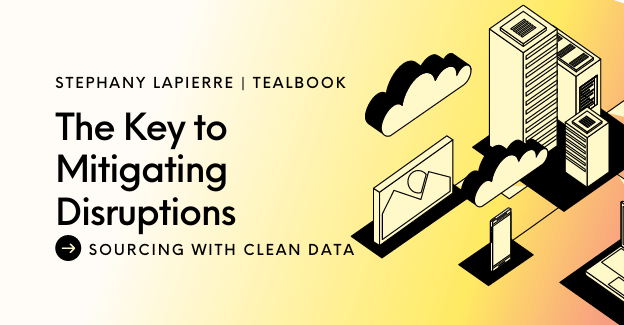The Key to Mitigating Disruptions: Sourcing with Clean Data
Most people who have used any sort of business software offhandedly consider the importance of maintaining quality data, but few make it a priority. Too often in my world, organizations will meticulously enter supplier information into a spreadsheet and dust off their hands. They see ongoing data quality as a difficult to achieve “nice-to-have,” accept the risk of bad data, and carry on with other business demands, fingers crossed. Not everyone realizes, however, the magnitude of that risk, especially around supplier data.
The True Cost of Bad Data
Relying on manual data entry (or non-entry) of supplier data costs businesses millions of dollars per year in overhead and lost savings. Without sufficient data on their suppliers and without the ability to quickly discover alternative suppliers, they are being outcompeted every time there is a disruption in supply or otherwise – and there are many disruptions, as we have all witnessed in the past few months alone.
They can’t find, diversify, localize or consolidate their suppliers in a short period of time. Rather, they have to wait until a large project is carried out. In effect, their options are limited, cost-saving opportunities with suppliers are lost and claimed by others, and supplier management goals aren’t met (or even reached for) on a day-to-day basis. And that’s baseline – not even scratching the surface of dedicated sustainability or supplier diversity programming.
Poor contingency planning is only one sign of low-quality supplier data harming your business. Other signs include:
● Unclear audit trails that necessitate referencing multiple sources in order to make decisions
● Employees making off-the-cuff web searches and emailing anomalous datasheets that may get entered into the ERP system (or any system)
● Maverick decision-making (employees not trusting or interacting with the ERP at all)
● Only verifying supplier information when wrapped up in a larger project, or via first-time onboarding
We often see data-cleansing projects that can involve having to chase hundreds of suppliers, many of whom are not even reachable or in business and this can result in inefficiencies that include failed supplier diversity efforts, under-met ESG criteria, and delayed payments and delivery of goods/services.
Opportunities That Miss the Mark
In addition, using poor supplier data can translate into missing KPIs that have been achieved. This happens when organizations don’t realize they are already tapping into a diverse and socially and environmentally responsible supplier base. Other ramifications of not having clean data include working with uncertified suppliers with bad practices who will eventually fail you, keeping outdated supplier information and certification statuses, falsely entering tax information and spending thousands of dollars per supplier record in employee overhead. In fact, we recently conducted a study that showed the cost of adding a single supplier record is $2,431.
Unfortunately, organizations do make attempts to enhance their data practices but through more implementations of department-specific ERPs which is expensive and creates multiple, contradictory sources of “truth.” So, it’s no wonder employees do work outside of their ERP systems and either 1) search for external data piecemeal or 2) rely on their own mentally stored knowledge.
Then, if those employees leave, their knowledge leaves with them. Organizations end up in a vicious cycle where the ERP becomes a beast that no one wants to feed. Expensive third parties might be brought in one or multiple times a year to help roll up data and get it cleaned, but once they leave, the cycle repeats itself. Companies are left with doubt, wasted IT efforts, and still have low-quality supplier data.
The best way to avoid a massive, manual clean-up project is to implement a cloud-based solution that doesn’t require a clean-up in the first place and can be easily plugged into any S2P, ERP or point solution. In other words, companies can be freed from time-consuming, messy IT projects and start with a clean slate. Cloud-based technology can harvest a company’s internal supplier data, plus publicly available supplier data on the internet, and compile that information into structured supplier records.
From then on, supplier records can be in one single place and considered a reliable source of truth, regularly updating and capturing all relevant and necessary details needed to do good business. Suppliers’ environmental impact, sustainability, diversity accreditations, location, company size, type of customer, year founded, supplier financial health and more can regularly be factored into decision-making.
These supplier details aren’t merely pulled from random corners of the internet either. Machine learning algorithms crawl the web to determine what supplier attributes should be discovered and can use buyer data and hundreds of supplier dimensions to identify similarities/trends between suppliers (no different from Netflix telling you what movie to watch tonight). The more this technology is used, the smarter it becomes, allowing buyers to be equipped with as much supplier intelligence as they possibly can be.
Building a More Equitable Supply Chain
Amid increasing supply chain disruptions, keeping a steady stream of clean supplier data is a must-have. Right now. It can’t be set aside and left for someone else to deal with in the future. A future with clean data means that when there are the inevitable supply chain disruptions, companies can know their backup sourcing options with a click or two.
With more of the supply chain utilizing clean data, the world will be more equitable, with smaller suppliers being considered as often as big ones. Companies will be more innovative, spending more time on the big picture and less time being forced to sweat the small stuff. Last but not least, organizations will be able to do business knowing they are supporting healthy work conditions, responsible sourcing, waste management and other climate change initiatives.
In short: clean data is not just about feeling organized and avoiding mistakes. Clean data means a clean future.









